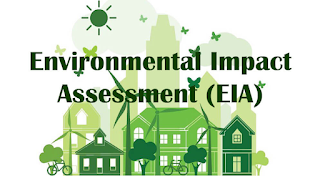An impact can be defined as any change in physical, chemical, biological, cultural or socio-economic environmental system as a result of activities relating to a project or adverse effects caused by industrial, infrastructural projects or by the release of a substance into the environment.
Definition of Impact Assessment
Impact assessment is the process of identifying the future consequences (bad results) of a proposed project. Impact Assessment ensures that projects, programs and policies are economically viable, socially equitable and environmentally sustainable.
Definition of Environmental Impact Assessment
The United Nations of Environmental Programme (UNEP ) defined that EIA is a tool used to identify the environmental and economic impacts of a project prior to decision making regarding the project planning, design, adverse impacts, etc.. For all proposed and development projects, whether Government or Private, the Ministry of Environment and Forests (MoEF) requires an Environmental impact assessment report related to the following parameters:
The report must define what impact it would have on water; soil and air including flora and fauna. Affect on the lives of local people.
To ensure that no way harm the environment on a short term or long term basis.
Why is EIA important?
By identifying potential alternatives and adverse impacts, Nations can better achieve goals for sustainable development; avoid adverse environmental; social and cultural impacts; reduces cost, provides better plan for infrastructure etc.
Classification of Impacts
Environment impacts arising from any development projects fall into three categories:
(i) Direct impacts
(ii) Indirect impacts and
(iii) Cumulative impacts.
According to their nature, these three groups reveal:
- Positive and negative impacts
- Reversible and irreversible impacts
- Light, moderate and severe impacts
- Local and widespread impacts
Short – term and long – term impacts For eg to construct a major project:
Direct impacts are related to:
(a) Aesthetics in the area (understanding of beautiful things);
(b) Traffic at nearby junctions,
(c) Removal of natural vegetation;
(d) Interference with natural water ways;
(e) Additional housing or commercial shops to support employees.
Significance of Effects
Significant effects are likely to occur where valuable resources are subject to impacts of severity. EIA is recognized by adopting the five levels of significance as described in the draft to good practice and procedures. These five levels of significances are:
Severe: Sites of national importance and unique resources ( to exist in only one place ) if lost, cannot be replaced or relocated.
Major: These effects are to be important considerations at a regional or district scale during the decision making process.
Moderate: These effects at a local scale are likely to be key decision making issues.
Minor: These effects may be raised as local issues but are unimportant in the decision making process.
Neutral: No effect, not significant.


Thank you for very usefull information.The information is very special daily classic news
ردحذفأزال المؤلف هذا التعليق.
حذفThank you for very usefull information.The information is very special
ردحذف